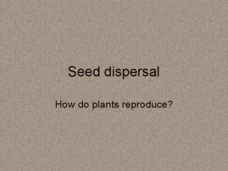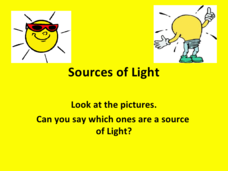Curated OER
My Face
This simple collection of slides shows a graphic of a facial feature with its name printed below. It can be used with primary learners or with English language learners to associate names with features. Graphics are large,...
Curated OER
Keeping Warm
There are five separate lessons about heat in this collection of slides. Young scientists learn how to use a thermometer to measure temperature, and they experiment with insulators. You can use one of these lessons each day for a full...
Curated OER
Labeling Forces Correctly!
Define six common forces: propulsion, air resistance, water resistance, friction, gravity, and upthrust. A picture of a Smart Car is displayed with arrows showing all of the forces acting on it when it is motion. A picture of a rubber...
Curated OER
Moving Around
Convey the structure and function of muscles to your class with this PowerPoint. It explains how muscles are composed of bundles of cells and fibers, that there are three muscle types, and that contraction is either voluntary or...
Curated OER
Plants
One slide reviews the main plant parts and most of the remaining slides address seven plant processes of life. This is a different approach to introducing the life of a plant. Three tasks are assigned to viewers on the last slide, making...
Curated OER
Rocks
Rocks rock! Humans use them for many things like tile, chalk, counter tops, and brick. Introduce young geologists to the many uses of rock with this presentation. Each slide shows a photo of a rock in its natural state alongside a photo...
Curated OER
Investigation: Evaporation
An evaporation investigation! This collection of slides walks future scientists through the process of setting up an experiment on how to speed up evaporation. The experiment is simple enough to use at the beginning of the school...
Curated OER
Seed Dispersal: Plant Reproduction
How do seeds get from a plant to the ground so they can germinate? This presentation provides the answer to seed dispersal in relation to plant reproduction. Straightforward explanations and definitions for wind, animal, burial, fruit,...
Curated OER
Sugar in Tea
Little chemists address whether or not you can get sugar back out of tea after it has dissolved. The PowerPoint itself simply walks them through the questioning process, considering different possibilities. The final slide settles on...
Curated OER
Biodiversity
Short and sweet, this presentation introduces tiny scientists to biodiversity. They view pictures of three different dogs and four different spiders and compare their physical characteristics. Explorers are then sent outdoors to find...
Curated OER
Condensation
If your class has studied condensation? Then they're ready to take this super-short quiz. They answer three questions related to the nature of condensation. This presentation is interactive and gives a thumbs up or down, depending on how...
Curated OER
Earthworms
Investigate the wonders of worms, earthworms to be precise. This presentation is perfect prior to studying earthworms in class. It provides basic information about their habitat, life cycle, predators, and what they like to eat.
Curated OER
Electricity Review
Are there different types of energy? Yes there are! Learn about the differences between heat, sound, light, and movement energy as they relate to electricity. This informative presentation could provide more detail explaining how light,...
Curated OER
Growing Up
This two-part resource helps little learners understand the life cycle. They view images that show how various creatures change from infancy to toddlerhood. Pupils use a circle to draw any life cycle they wish, showing it in four major...
Curated OER
Heating and Cooling Materials
When an object is heated or cooled, a change occurs. Learners will work through this presentation and decide whether or not the changes are reversible. They learn about heating and cooling, then assess changes that have taken place. This...
Curated OER
Interdependence and Adaptation
Find out how camels and polar bears are each perfectly suited to their environments because of their physical adaptations. Several key features of each animal are discussed along with how those features work in their specific...
Curated OER
Moving and Growing: Joints
Introduce the three types of joints found in the human body. Hinge, ball and socket, and sliding joints are discussed, examined, and defined in this short, yet informative presentation. There are a few pair-share opportunities suggested...
Curated OER
Plant Life Cycle
Before you fill those pots with dirt and plant those seeds, describe the plant life cycle. Seed dispersal, germination, and pollination are all covered in this text-rich presentation. Each slide does contain quite a bit of text and...
Curated OER
Planning a Scientific Investigation
This slide show provides an opportunity of you and your class to plan your own scientific investigation. Each slide contains one part of the scientific hypothesis-building process and a space to type in what the class chooses to focus...
Curated OER
Separating Materials
A chemistry presentation focuses on mixtures. Learners consider many sets of mixtures, such as sand and water, and marbles and water. They decide which mixture can be separated, then are led through a process to do just that. A fun and...
Curated OER
Sources of Light
In pairs, learners will consider and discuss each of the provided slides to determine which objects are a source of light. Items include, but are not limited to, lamps, windows, pencils, mirrors, and the sun; these items are great for...
Curated OER
Springs
Springs are amazing. Here, learners are presented with springs found in various everyday objects. They discuss which springs they think will have the most force, then test their hypothesis. This presentation has the start of a good idea...
Curated OER
The Moon
A very good presentation on the phases of the moon can be helpful for your young scientists. An excellent description of why there are different phases of the moon each night is included in the PowerPoint, along with illustrations that...
Curated OER
Our Class Woodlice
An experiment which determines the preferred habitat of wood lices's is the focus of this presentation. The woodlice are placed in a container that has four different environments, and each group of learners predicts which one they will...
Other popular searches
- Earth Science
- Physical Science
- Life Science
- Science Project
- Science Space
- Environment Science
- History of Science
- Environmental Science
- Pe Science
- Family and Consumer Science
- Consumer Science
- Social Science























